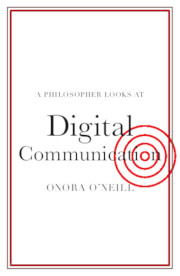Refine search
Actions for selected content:
237 results
Modern Moral Philosophy and the Problem of Relevant Descriptions
-
-
- Book:
- Moral Philosophy
- Published online:
- 19 May 2022
- Print publication:
- 09 June 2022, pp 468-493
-
- Chapter
- Export citation
Duties and Virtues
-
-
- Book:
- Ethics
- Published online:
- 14 January 2023
- Print publication:
- 09 June 2022, pp 168-189
-
- Chapter
- Export citation
2 - Acts and Content, Norms and Harms
- from Part I - Complex Communication
-
- Book:
- A Philosopher Looks at Digital Communication
- Published online:
- 20 January 2022
- Print publication:
- 10 February 2022, pp 15-27
-
- Chapter
- Export citation
1 - Presuppositions of Communication
- from Part I - Complex Communication
-
- Book:
- A Philosopher Looks at Digital Communication
- Published online:
- 20 January 2022
- Print publication:
- 10 February 2022, pp 3-14
-
- Chapter
- Export citation
Some Suggestions for Further Reading
-
- Book:
- A Philosopher Looks at Digital Communication
- Published online:
- 20 January 2022
- Print publication:
- 10 February 2022, pp 129-131
-
- Chapter
- Export citation
3 - Communication and New Technologies
- from Part I - Complex Communication
-
- Book:
- A Philosopher Looks at Digital Communication
- Published online:
- 20 January 2022
- Print publication:
- 10 February 2022, pp 28-43
-
- Chapter
- Export citation
Part I - Complex Communication
-
- Book:
- A Philosopher Looks at Digital Communication
- Published online:
- 20 January 2022
- Print publication:
- 10 February 2022, pp 1-58
-
- Chapter
- Export citation
Part III - Politics and Connectivity
-
- Book:
- A Philosopher Looks at Digital Communication
- Published online:
- 20 January 2022
- Print publication:
- 10 February 2022, pp 89-114
-
- Chapter
- Export citation
Part II - Norms and Standards in a Connected World
-
- Book:
- A Philosopher Looks at Digital Communication
- Published online:
- 20 January 2022
- Print publication:
- 10 February 2022, pp 59-88
-
- Chapter
- Export citation
Preface
-
- Book:
- A Philosopher Looks at Digital Communication
- Published online:
- 20 January 2022
- Print publication:
- 10 February 2022, pp xi-xvi
-
- Chapter
- Export citation
7 - Power and Anonymity
- from Part III - Politics and Connectivity
-
- Book:
- A Philosopher Looks at Digital Communication
- Published online:
- 20 January 2022
- Print publication:
- 10 February 2022, pp 91-114
-
- Chapter
- Export citation
Contents
-
- Book:
- A Philosopher Looks at Digital Communication
- Published online:
- 20 January 2022
- Print publication:
- 10 February 2022, pp vii-x
-
- Chapter
- Export citation
6 - Duties and Rights 2: Rights to Privacy
- from Part II - Norms and Standards in a Connected World
-
- Book:
- A Philosopher Looks at Digital Communication
- Published online:
- 20 January 2022
- Print publication:
- 10 February 2022, pp 75-88
-
- Chapter
- Export citation
5 - Duties and Rights 1: Freedom of Expression
- from Part II - Norms and Standards in a Connected World
-
- Book:
- A Philosopher Looks at Digital Communication
- Published online:
- 20 January 2022
- Print publication:
- 10 February 2022, pp 61-74
-
- Chapter
- Export citation
Index
-
- Book:
- A Philosopher Looks at Digital Communication
- Published online:
- 20 January 2022
- Print publication:
- 10 February 2022, pp 132-140
-
- Chapter
- Export citation
Notes
-
- Book:
- A Philosopher Looks at Digital Communication
- Published online:
- 20 January 2022
- Print publication:
- 10 February 2022, pp 115-128
-
- Chapter
- Export citation
Copyright page
-
- Book:
- A Philosopher Looks at Digital Communication
- Published online:
- 20 January 2022
- Print publication:
- 10 February 2022, pp vi-vi
-
- Chapter
- Export citation
4 - Digital Hopes
- from Part I - Complex Communication
-
- Book:
- A Philosopher Looks at Digital Communication
- Published online:
- 20 January 2022
- Print publication:
- 10 February 2022, pp 44-58
-
- Chapter
- Export citation

A Philosopher Looks at Digital Communication
-
- Published online:
- 20 January 2022
- Print publication:
- 10 February 2022
7 - Justice without Ethics: A Twentieth-Century Innovation?
- from Part II - Values
-
-
- Book:
- The Cambridge Companion to the Philosophy of Law
- Published online:
- 15 June 2020
- Print publication:
- 02 July 2020, pp 135-151
-
- Chapter
- Export citation
